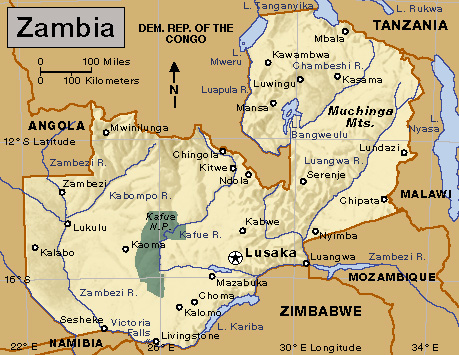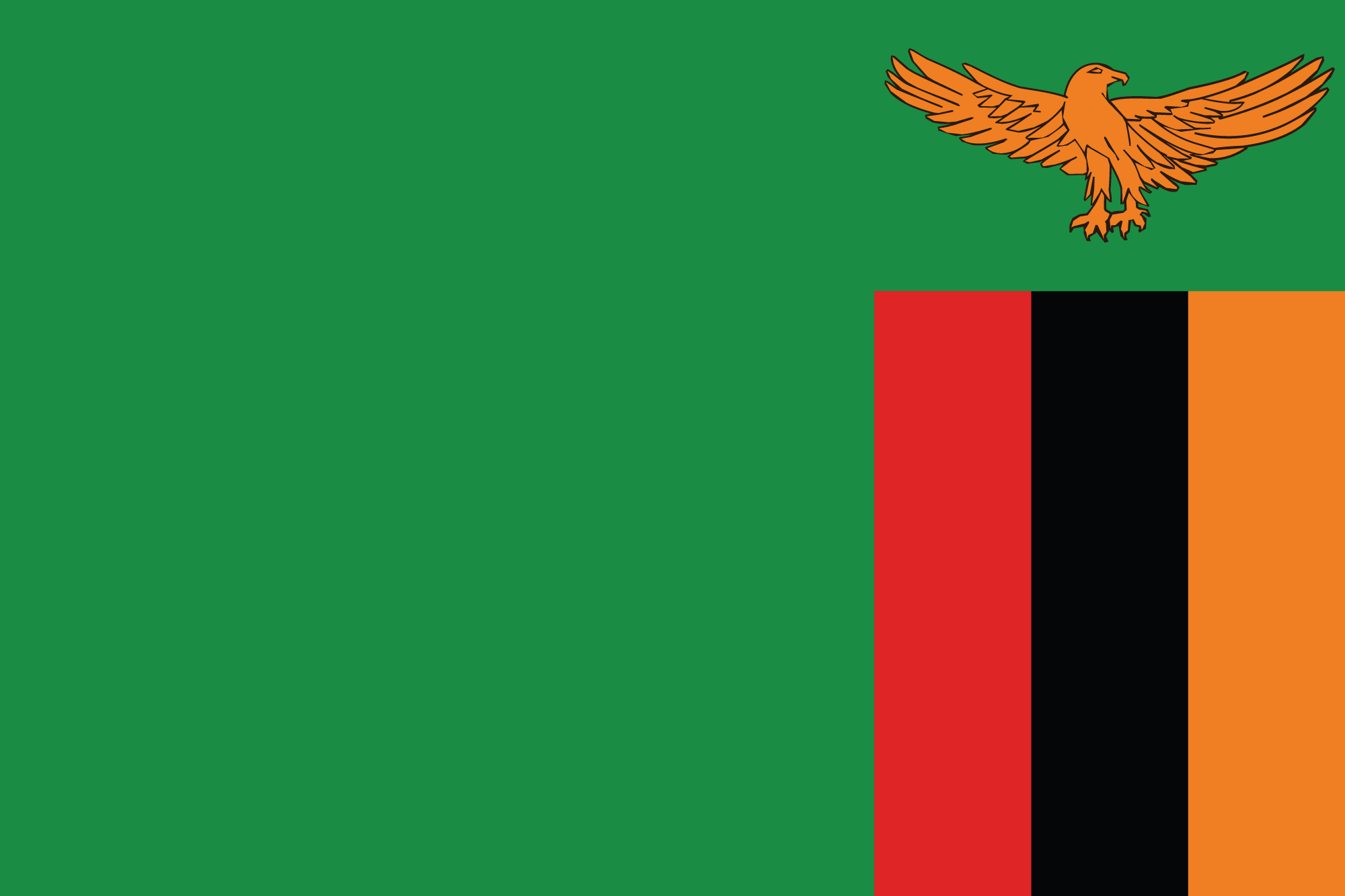Zambia << ZAM bee uh >> is a country in south-central Africa. It ranks as one of the world’s largest producers of copper. Zambia exports copper to many parts of the world and gains much income from the exports.

Zambia takes its name from the Zambezi River, which forms most of the country’s southern border. Victoria Falls, one of the world’s most beautiful waterfalls, lies on the river. The great Kariba Dam, one of the world’s largest hydroelectric projects, and Kariba Lake also are on the Zambezi River, serving both Zambia and Zimbabwe.
Zambia was formerly a British protectorate called Northern Rhodesia. From 1953 to 1963, it formed part of the Federation of Rhodesia and Nyasaland with Nyasaland (now Malawi) and Southern Rhodesia (now Zimbabwe). Zambia became an independent nation in 1964. Lusaka is its capital and largest city.
Government.
A president serves as head of state and government and is the most powerful official in Zambia. Voters elect most of the members of the National Assembly, the country’s legislature, though a few members are appointed by the president. The speaker of the Assembly and the president are also members of the Assembly. The people of Zambia elect the president, vice president, and the Assembly members to five-year terms. The president appoints a Cabinet, which, with the vice president, helps run the day-to-day affairs of the government. Political parties in Zambia include the Movement for Multiparty Democracy (MMD), the Patriotic Front (PF), and the United Party for National Development (UPND).

The country is divided into 10 provinces. Each province is administered by an appointed deputy minister.
People.
Most Zambians speak Bantu languages (see Bantu). There are more than 70 ethnic groups represented and eight major local languages spoken in Zambia. Many people also speak English, the official language. In remote parts of the country, village life goes on much as it has for hundreds of years. The people live in circular, grass-roofed homes and raise food crops on the surrounding land. The development of mining has caused thousands of Zambians to move to mining towns.
Corn is the main food. A favorite dish is nshima, a thick porridge made from corn. The people plant their crops in November and December.
The majority of Zambians are Christians, but traditional local beliefs still have a strong hold on the village people. However, the use of traditional medicine, and old customs such as polygyny (marrying several wives) and bride price (paying the parents for a bride), are slowly dying out in the towns.
Most Zambian children attend elementary school. But only a fifth of them go to high school. The University of Zambia is in Lusaka, and Copperbelt University is in Kitwe. Zambia also has several trade and technical schools.

Land.
Most of Zambia is flat and covered with trees and bushes. It lies on a plateau about 4,000 feet (1,200 meters) above sea level. The plateau is broken by the 7,000-foot (2,100-meter) Muchinga Mountains in the northeast. In the south, the trees are smaller, and there are large open areas. The Zambezi River flows south through western Zambia and forms much of the southern border. Every year, it floods a broad, sandy plain in Western Province in the southwest.

Because of its altitude, Zambia has a milder climate than might be expected. The hot season lasts only from September through November. Midday temperatures then range between 80 and 100 °F (27 and 38 °C). From November through April, Zambia has a rainy season. Violent storms flood the rivers by March. From May through August, temperatures range from 60 to 80 °F (16 to 27 °C). Northern Zambia gets about 50 inches (130 centimeters) of rainfall a year. The south gets 20 to 30 inches (51 to 76 centimeters).
Economy.
Zambia is a poor country. Many of the country’s people live in poverty. Zambia relies heavily on foreign aid.
Zambia is one of the world’s leading producers of copper. Copper accounts for over half of Zambia’s export earnings. Several copper mines lie in an area called the copperbelt, along Zambia’s border with the Democratic Republic of the Congo (DRC). Valuable amounts of cobalt are obtained as by-products of copper mining.
Most of Zambia’s workers are farmers. Corn is the most important farm product. Other leading crops include cassava, peanuts, sugar cane, tobacco, and vegetables. Farmers also raise beef and dairy cattle. Zambia’s factories refine copper and produce chemicals, food and beverage products, and textiles.
Zambia has no outlet to the sea. Railroads connect the country with seaports in Angola, Mozambique, and Tanzania. Mpulungu has a port on Lake Tanganyika. Lusaka has an international airport.
History.
In 1851, the Scottish missionary David Livingstone crossed the Zambezi from the south. He spent nearly 20 years exploring the region.
In the late 1800’s, Cecil Rhodes’s British South Africa Company made treaties with African chiefs in the area. In 1897, the company named the area Northern Rhodesia to distinguish it from the region south of the Zambezi, which it called Southern Rhodesia.
In 1924, the British government took over the administration of Northern Rhodesia and appointed a governor. Copper had been mined in the area for hundreds of years. The discovery of large copper ore deposits in the late 1920’s brought a rush of Europeans to the area. Ten years later, mining was an important industry.
After World War II ended in 1945, the Europeans asked the United Kingdom for greater control of the government. Many wanted the merger of Northern Rhodesia with Southern Rhodesia. The Africans of Northern Rhodesia opposed these demands. But in 1953, the United Kingdom formed a federation of Northern Rhodesia, Southern Rhodesia, and Nyasaland. The Africans opposed the federation because the European minority controlled the government in Southern Rhodesia. The United Kingdom dissolved the federation in 1963. On Oct. 24, 1964, Northern Rhodesia became the independent nation of Zambia. Kenneth Kaunda was elected president in 1964. He was reelected in 1968, 1973, 1978, 1983, and 1988. In 1972, the UNIP became the only legal political party in Zambia.
Southern Rhodesia came to be called Rhodesia after the federation was dissolved. In 1965, Rhodesia declared its independence in defiance of the United Kingdom. Relations between Zambia and Rhodesia became strained because Rhodesia’s white minority government refused to give the African majority a greater voice in government.
Zambia experienced serious economic problems in the 1970’s, 1980’s, and 1990’s. In 1973, Rhodesia prohibited Zambia from shipping goods across its territory, eliminating one of Zambia’s main outlets to the sea. Rhodesia soon lifted the ban. But until 1978, Zambia refused to ship goods across Rhodesia. In 1980, blacks gained control of Rhodesia’s government, and the country’s name was changed to Zimbabwe. Relations then improved between Zambia and Zimbabwe. Zambia’s economy also suffered from low market prices for copper and a reduction in copper ore reserves.
Zambia legalized opposition political parties in 1990. In the multiparty elections of 1991, Frederick Chiluba, head of the MMD, was elected president. He defeated Kaunda in the election. Chiluba was reelected in 1996. In 2001, Levy Mwanawasa of the MMD was elected president. Also in the early 2000’s, a severe drought led to widespread food shortages in Zambia. In 2006, Mwanawasa was reelected president.
In 2008, Mwanawasa died after suffering a stroke. Vice President Rupiah Banda became acting president. Banda was then elected to serve out the rest of Mwanawasa’s term. In 2011, Michael Sata of the Patriotic Front was elected to succeed Banda as president. Sata died in October 2014. In January 2015, Edgar Lungu of the Patriotic Front was elected to serve the rest of Sata’s term. Lungu was elected to a full presidential term in 2016. In 2021, Hakainde Hichilema was elected president. As opposition leader, Hichilema had previously failed in five attempts to win the presidency. Over several years, however, he had gained support from millions of young voters who appreciated Hichilema’s desire to tackle the country’s high debt and unemployment, as well as his relatable content on social media.
